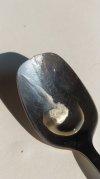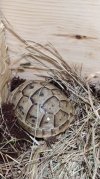Hi, Im a beginner tortoise owner, just got my beloved Greek Tortoise(I believe he`s an TG Ibera, although he hasnt developed a moving back part of a plastron yet). He turned 2 y.o. a month ago and it`s been a week since I got him. Breeder told me that this little guy is from Macedonia, but I cant find that info on his CITES. He used to live in an outdoor enclosure with other tortoises, one of those was his brother and other 3 were Marginated tortoises, and he did brumate his 2 winters. He is now living inside in a tortoise table which is 5ft by 1.6ft(150cm*50cm*20cm), fisrtly, I`ve made a quartz sand substrate for him, in which he was moderately active, but I`ve noticed signs of dehydration - urates(toothpaste consistency, but with every poo) and a peeling skin behind he`s back legs, he never went for a drink, even tho he had a fresh water dish all the time, and I`ve bathed him once in 2 days. It was hard to maintain humidity levels above 35% with a quartz sand.
So I bought him a coconut coir, and at first he seemed to really like it, for 2 days he was active for 7-9 hours, gladly went out of his safe space aka closed and colder part of a table with a hay shelter, ate enough, went to a sun spot etc. But last day he didn`t get out as usual, spent almost the whole day inside of a shelter, barely touched his food, and didn`t defecate. For the fisrt time he burrowed in a coir for a night, now he did it again. He started biting his basking shellfish after the substarate change, too. I thought he might lack Calcium at first, but he tried to bite his water plate as well, so I`m confused about that, Urates do seem healthy enough, is he just trimming his beak this way?
He has a sun basking area with UVB and UVA lamp, that gets the spot to a constant 32C(Repti-Zoo SuperSun 160W), cold spot doesn`t drop below 25C for now, humidity with coconut coir was 65% at first, now it dropped to ~50%, fresh water dish is always there, he has hills to climb, Nephrolepis to hide behind and munch from time to time.
I do feed him once a day, portion is sized just enough to cover his shell.
His diet is dandellion leafs, rocket salad(Eruca vesicaria), occasional cucumber(breeder use to give him cucumbers regularly so he enjoys them), green leaf lettuce, occasional bulgarian pepper(he ate it two times, both times destroying every cm of it), clever, rarely an non sweet apple(once), occasional green squash, and once I gave him aloe, but he only had a bite and ignored it for 2 days. He did grab a few bites of rocket salad last day, but thats it.
He has no signs of RI or other health issues, always up on his legs while walking, he do be extending his neck and even gets on his back legs to get to Nephrolepsis leaves, the main disturbing thing is that some coconut coir does get on his food, not to make food unedible, but enough for him to eat it. Im not sure if he has problems metabolising it, can it cause any other health problems etc?
So I bought him a coconut coir, and at first he seemed to really like it, for 2 days he was active for 7-9 hours, gladly went out of his safe space aka closed and colder part of a table with a hay shelter, ate enough, went to a sun spot etc. But last day he didn`t get out as usual, spent almost the whole day inside of a shelter, barely touched his food, and didn`t defecate. For the fisrt time he burrowed in a coir for a night, now he did it again. He started biting his basking shellfish after the substarate change, too. I thought he might lack Calcium at first, but he tried to bite his water plate as well, so I`m confused about that, Urates do seem healthy enough, is he just trimming his beak this way?
He has a sun basking area with UVB and UVA lamp, that gets the spot to a constant 32C(Repti-Zoo SuperSun 160W), cold spot doesn`t drop below 25C for now, humidity with coconut coir was 65% at first, now it dropped to ~50%, fresh water dish is always there, he has hills to climb, Nephrolepis to hide behind and munch from time to time.
I do feed him once a day, portion is sized just enough to cover his shell.
His diet is dandellion leafs, rocket salad(Eruca vesicaria), occasional cucumber(breeder use to give him cucumbers regularly so he enjoys them), green leaf lettuce, occasional bulgarian pepper(he ate it two times, both times destroying every cm of it), clever, rarely an non sweet apple(once), occasional green squash, and once I gave him aloe, but he only had a bite and ignored it for 2 days. He did grab a few bites of rocket salad last day, but thats it.
He has no signs of RI or other health issues, always up on his legs while walking, he do be extending his neck and even gets on his back legs to get to Nephrolepsis leaves, the main disturbing thing is that some coconut coir does get on his food, not to make food unedible, but enough for him to eat it. Im not sure if he has problems metabolising it, can it cause any other health problems etc?
Attachments
Last edited:

